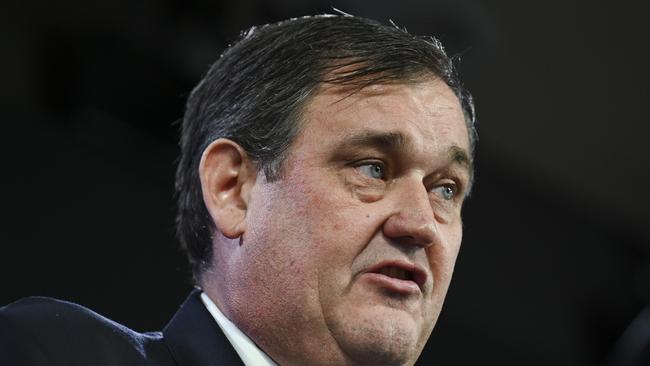Alinta Energy quietly shelves WA offshore wind project as field of potential developer thins
The withdrawal of Alinta Energy from WA’s offshore wind race thins the field as concern grows about the industry’s future.
Business
Don't miss out on the headlines from Business. Followed categories will be added to My News.
Alinta Energy, Australia’s fourth-largest electricity and gas retailer, has quietly axed plans to develop an offshore wind energy project in Western Australia, as it concentrates its focus on a Victorian development.
The move cuts the number of potential developers looking for a licence to develop in WA, and will do little to quell anxiety about global interest in Australia’s offshore wind market amid doubts about the commitment of the Coalition to the industry and uncertainty about Victoria’s capacity to meet its ambitious target.
The federal Labor government has earmarked offshore wind as a critical piece of its net zero emissions by 2050 plan, and prospective industry spurred a wave of interest from international giants and domestic players.
But illustrating a moderation of interest from some quarters, Alinta Energy has become the latest to trim its Australian offshore wind ambition and The Australian understands it will not submit an application for a feasibility licence in WA.
A source familiar with the plans of Alinta said the company – owned by Hong Kong-based Chow Tai Fook Enterprises, said the decision was made to allow it to focus on its Victorian offshore wind project – known as Spinifex.
Alinta earlier this year partnered with JERA – Japan’s largest power generation company – to jointly develop the 1.2GW Spinifex project in southwest Victoria.

The Australian understands that with Alinta’s withdrawal from WA, just Parkwinds, owned by JERA, Flotation Energy, OceanEx remain in the running.
Prospective developers must submit their applications by the end of January 2025 – a deadline that federal Energy Minister Chris Bowen extended last month, citing the Flotation victory in court.
Flotation successfully won a legal challenge against Mr Bowen’s justification for rejecting its bid for a development licence in Victoria. Flotation was widely seen as Australia’s second most advanced offshore wind project, but Mr Bowen rejected its application after a tiny, largely insufficient boundary dispute with rival, Iberdrola.
Mr Bowen must soon make a decision on whether to award a licence to Flotation. Should Flotation proceed with an application for WA, it will test the relationship between Mr Bowen and Flotation.
Industry sources said Mr Bowen will likely have been embarrassed by Flotation’s victory, but with Labor putting great stock into offshore wind – he needs the expertise of the UK-based renewable energy developer.
Mr Bowen is already under pressure to prove the offshore wind industry remains attractive. While more than three dozen applications were made for the Gippsland region, interest in NSW particularly has been muted. Industry sources flagged the Coalition’s pledge to scrap one of two NSW’s regions earmarked for offshore wind as a major contributing factor.
Victoria is the most attractive to developers as strong winds and shallow coastlines make it ideal for offshore wind, and some 12 developments are currently progressing early works,
Victoria has placed offshore wind at the heart of its plan to wean from coal. Victoria is Australia’s most fossil fuel-dependent state, relying on three major coal power stations for baseload electricity and gas to meet increased demand throughout winter.
The state government in 2022 set a target of generating about 20 per cent of its energy needs from offshore wind within a decade. The target then doubles to 4GW by 2035 and 9GW by 2040. In all, Victoria sees potential for 13GW of offshore wind capacity by 2050, five times the current renewable generation in Victoria.
The target has been widely heralded, but developers are concerned about the state’s capacity to financially support the industry as debt levels soar.
The state Labor government has pledged to hold the first offshore wind auction next year. Such auctions set the minimum and maximum return a developer would receive once generating electricity. Projects typically are only viable once they have secured an agreement.
Victoria can ill-afford to sow seeds of doubt as a growing number of countries earmark offshore wind growth, which could persuade some developers that Australia is not comparative as attractive.
There is also concern about rising costs of wind turbines, while Macquarie-owned Corio, one of the developers to have secured a development licence in Victoria, is up for sale.
It is unclear whether Corio will proceed with the Gippsland development should it not find a new owner, and one industry executive said he was pessimistic that interest would be high.
“Macquarie needs to find a suitor who wants to spend some $30m a year in development fees, that is a tall order,” the source who had been approached seeking interest said.
More Coverage
Originally published as Alinta Energy quietly shelves WA offshore wind project as field of potential developer thins





